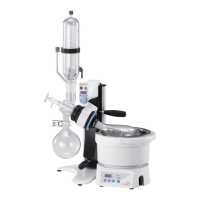
Do you have a question about the EYELA N-1300 Series and is the answer not in the manual?
| Type | Rotary Evaporator |
|---|---|
| Lift Mechanism | Manual |
| Evaporating Flask Capacity | 3L |
| Cooling Method | Water |
| Power Supply | 100V 50/60Hz |
Provides crucial safety warnings for operating the rotary evaporator, including avoiding contact with moving parts and hot surfaces.
Explains the intended use of the rotary evaporator for condensation, purification, and fractional distillation.
Details the technical specifications for different N-1300 models, including performance and dimensions.
Illustrates and labels the various components of the N-1300S type rotary evaporator.
Illustrates and labels the various components of the N-1300V type rotary evaporator.
Illustrates and labels the various components of the N-1300E type rotary evaporator.
Describes the buttons, lamps, and display on the control panel for operating the unit.
Details the safety functions and alarm indicators, such as abnormal rotation and power outage recovery.
Specifies the required environmental conditions for safe and optimal installation of the rotary evaporator.
Provides instructions on connecting the power supply, emphasizing voltage, phase, and receptacle confirmation.
Guides users through essential preparatory steps before operating the rotary evaporator, including jack and glass part handling.
Details the procedure for correctly installing the rotary joint into the driving assembly.
Explains the correct method for installing the main and sub seals to ensure proper vacuum levels.
Detailed steps for installing the cooler and connecting flasks for the S type glass set.
Detailed steps for installing the cooler and connecting flasks for the V type glass set.
Detailed steps for installing the cooler and connecting flasks for the E type glass set.
Explains how to switch the unit to a reverse rotation configuration for specific applications.
Instructions for installing the support bar clamp, crucial for stability and certain configurations.
Details how to adjust the angle of the drive body, ensuring proper alignment and stability.
Guides on connecting the vacuum and coolant hoses, emphasizing correct ports and hose types.
Instructions for connecting the optional fingertip cooling hose for specialized cooling needs.
Details the process of installing the AC adapter and connecting the power supply cord for operation.
Highlights critical safety warnings during operation, including stopping on abnormalities and handling hot components.
Explains how to set the rotation mode (positive, negative, timer reversal) for the specimen flask.
Details how to configure the power outage recovery function for automatic rotation resumption or stop.
Guides on how to change and set the desired number of rotations for the evaporator.
Instructions for setting the timer reversal mode, including rotation number and time.
Steps for performing the concentration process, including setting specimens and decompressing the evaporator.
Procedures for safely stopping the rotary evaporator and its associated components.
Provides solutions for common problems like display errors, rotation issues, noise, and vacuum leaks.
Addresses specific error codes and alarms, such as rotation error and power outage recovery, with resolution steps.
Guidelines for cleaning and maintaining the rotary evaporator, emphasizing safety and proper methods.
Instructions for identifying and replacing worn consumable parts like seals and springs.
Information on the correct disposal methods for the main unit and its components.
Outlines procedures for requesting repairs, warranty service, and post-guarantee support.
Provides physical properties and vacuum levels for common substances used in distillation.
